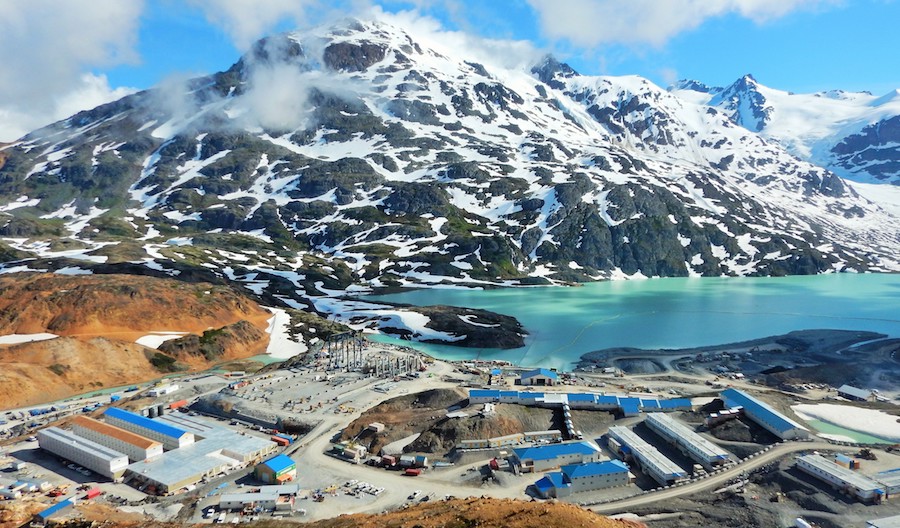Amanda Stutt | January 3, 2022

Brucejack mine, under construction in 2016. (Image courtesy of Pretium Resources.)
The $2.8 billion acquisition by Australia’s 2nd biggest gold miner, Newcrest (ASX, TSX: NCM) of Canada’s Pretium Resources (TSX, NYSE: PVG) late last year marked a new beginning for the Brucejack mine, Pretium’s former flagship asset and one of the highest grade gold mines in the world.

The Brucejack project spans 1,200 square kilometres in the heart of British Columbia’s Golden Triangle, which has a 100-year mining history and also hosts the Red Chris, Eskay Creek and Snip mines. The important Brucejack deposit was prospected as early as the 1980s.
But the real Brucejack mine story started 1999, when it was acquired by Silver Standard, which held a 60% interest at the time of what consisted of about 3,000 hectares and a few exploration prospects. The story really started to gain momentum in August 2009, when Silver Standard reported an intercept of 16,948 gram per tonne gold over 1.5 metres.
In 2010 Pretuim IPO’d on the TSX, raising C$280 million via private equity, offtake agreements, and a precious metals stream. It acquired Brucejack from Silver Standard for $450 million in October that year.
But the road to production would prove to be rocky.
Five years later, on September 5, 2015, construction began at Brucejack, somewhat of an anomaly when it comes to the persistent permitting processing backlogs in British Columbia miners have to contend with.
It began commercial production on July 1, 2017, financed during one of the most protracted mining downturns in history, when few investors were putting money into new mines, somewhat of an anomaly in mining when it comes to cash flow in the mining sector.
Shares in Pretium tanked in early 2018 after the company announced disappointing production and cost forecasts. From the outset the company failed to achieve production guidance with consecutive results reporting lower-than-expected mine grades and higher all-in sustaining costs.
However, a 2020 technical report estimated gold production of 311,000 ounces per year, at an all-in sustaining cost (AISC) of $743 per ounce, over a projected mine life of 13 years. In 2021, the mine is anticipated to produce between 325,000 and 365,000 ounces of gold. That’s a far cry from the $1 billion mine’s initial commitment to producing roughly 500,000 ounces gold annually for the first eight years of the mine’s 18-year mine life, at an AISC of $446 per ounce of gold.
High-grade, gold-silver mineralization at the Valley of the Kings occurs in steeply dipping and predominantly east- to northwest-trending quartz stockwork veins and breccia zones, inside a broader halo of clay alteration and low-grade mineralization.
Brucejack consists of the Valley of the Kings deposit, and the result is that the gold mineralization is “nuggety,” which makes it hard to mill with predictable output.
Enter 2021
As of January 1, 2021, Brucejack’s Valley of the Kings deposit held a compliant proven and probable reserve base of 11.5 million tonnes grading 8.7 grams per tonne gold and 9.8 grams per tonne silver, for 3.2 million ounces ad 3.6 million ounces of gold and silver metal, respectively.
The West Zone also holds proven a probable reserves totalling 29 million tonnes grading 6.8 grams per tonne and 278.5 grams per tonne for a respective 600,000 ounces gold and 26 million ounces silver, respectively.
Brucejack and surrounding tenements are within the traditional territories asserted by the Tsetsaut Skii km Lax Ha and Tahltan Nation, and in the Nass Area of Nisga’a Nation.
That year, Pretium Resources did not disappoint when it made a new high-grade gold exploration discovery at the Golden Marmot Zone at Brucejack.
The company said it had received assays for the first nine drill holes, eight of which intersected gold with a highlight of 53.5 metres grading 72.5 grams per tonne gold including 05 metres grading a bonaza 6,700 grams per tonne gold and 3,990 grams per tonne silver.
“Initial results from Golden Marmot are exciting and affirm the district-scale potential of the Brucejack property,” president and CEO Jacques Perron said in an October 2021 statement.
In November, Newcrest made its move and announced the acquisition.
“We are delighted to be expanding our presence in this highly prospective region in British Columbia. Brucejack is a Tier 1 mine in a Tier 1 jurisdiction and will deliver immediate production, free cash flow and earnings diversification to Newcrest and will fit seamlessly into our long-life, low-cost portfolio,” Newcrest CEO Sandeep Biswas said in a media release.
“The combination of Newcrest and Pretivm will create the leading gold miner in British Columbia’s Golden Triangle, operating both the Brucejack and Red Chris mines,” Biswas said.
“Newcrest specializes in what I call tier-one deposits,” Biswas said in a recent interview with The Northern Miner. “We have a clear strategy where we want to continue to gain exposure to tier-one deposits, which in our terminology is typically 300,000-plus ounces per year equivalent, comprising copper if available, and gold.”
Newcrest will bring its extensive block-caving and epithermal vein experience to the table, which could entail a philosophical step-change for how the future Brucejack asset will be operated.
While Brucejack’s past has seen some hiccups, its future seems bright given the experience a top-tier miner like Newcrest has.
No comments:
Post a Comment